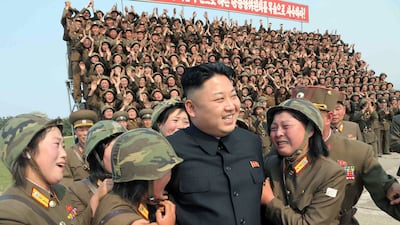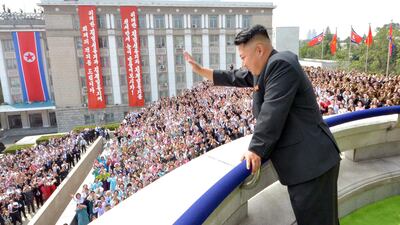North Korea has increased its number of missile launches in the past month, including what it calls “hypersonic” weapons tests.
The country’s missile engineers and scientists may have a high profile within leader Kim Jong-un's government – but little is known about them to the rest of the world.
Analysts say Mr Kim is expected to make them part of his long-term military plans.
Here is what we know – and what we don’t – about these key personnel in North Korea.
Who are North Korea's missile scientists?
Very little is known about the mid-level and working-level scientists and technicians involved in missile research and development.
Analysts say these scientists appear to have guaranteed job security because of the resources and effort expended to educate and train them and they are sequestered to special districts so that they are neither a defection risk nor a political or social nuisance to the regime.
“Unlike economic cadres or even military commanders, this is a population that is not easily replaced,” Michael Madden, a North Korea leadership expert at the Washington-based Stimson Centre, told Reuters.
Many of them attend Kim Jong-un National Defence University, a training ground for North Korean defence-related science and technology specialists that has reportedly added a college focused on “hypersonic missile technology”.
The scientists and engineers often appear split into competing teams designing similar types of weapons, allowing them to go down numerous routes to assess which technology is the most promising, said Ken Gause, director of the International Affairs Group at CNA, a non-profit research and analysis organisation based in Arlington, Virginia.
A 2018 study by the James Martin Centre for Non-proliferation Studies (CNS) found North Korean scientists had worked with researchers in other countries to co-write at least 100 published articles that had identifiable significance for dual-use technology, weapons of mass destruction (WMD) or other military purposes.
Who leads the missile programme?
Mr Kim relies on three people to lead the secretive country’s rapidly accelerating missile programme.
They include former air force general Ri Pyong-chol, veteran rocket scientist Kim Jong-sik and Jang Chang-ha, head of a weapons development and procurement centre.
A fourth official – Pak Jong-chon, the chief of the General Staff – has also assumed a higher-profile role in the Military Industry Department (MID), which is responsible for the production of strategic weapons, according to Mr Gause.
"We have seen a lot of changes in the military industry arena in the last few years," said Mr Gause.
Mr Pak oversaw many recent tests in the absence of Mr Kim, who did not attend any missile launches in 2021 but observed one of the hypersonic missile tests in January.
Last year, Yu Jim was appointed to lead the MID. Mr Yu was previously a representative of North Korea’s primary state arms dealer in Iran, according to Mr Madden.
What are the organisations?
The Academy of National Defence Science (Nads), also known as the Second Academy of Natural Sciences (Sans), oversees North Korea's missile development.
Mr Madden said the state of a weapon's development can often be divined from who is reported to have attended a test.
An event where the only personnel are from Nads means the weapon is still at the research and development phase, for example. If an event combines Nads and the Second Economic Committee, that often means that the weapon is moving from development to production and manufacturing.
Finally, if personnel from the military’s General Staff Department (GSD) attend a test, such as the recent railway-borne missile launch, this usually indicates that the weapon is finished and will be deployed.
There are initial signals that as North Korea completes its missile and nuclear arsenal, it may fold more elements of its Strategic Forces back under GSD, signalling that it has moved to an operational role, Mr Madden said.
Does North Korea receive any foreign assistance?
North Korea’s missile programme has roots in the assistance it received from the Soviet Union, and later Russia, analysts say, and the boosters involved in propelling the latest hypersonic warheads are similar to Soviet designs.
There is debate as to what extent that assistance has continued since the 1990s.
According to the latest sanctions designations by the US, North Koreans linked to Nads in China and Russia continue to procure materials and technical information for North Korea’s WMD and missile programmes, aided by at least one Russian telecoms company and a Russian citizen.
Markus Schiller, a Europe-based missile expert, said North Korea’s success in testing suggests it has had external support.
But he noted that under Mr Kim, the country's missiles failed more often than they did in the past, suggesting that he is testing more home-grown designs than his predecessors.
Know your Camel lingo
The bairaq is a competition for the best herd of 50 camels, named for the banner its winner takes home
Namoos - a word of congratulations reserved for falconry competitions, camel races and camel pageants. It best translates as 'the pride of victory' - and for competitors, it is priceless
Asayel camels - sleek, short-haired hound-like racers
Majahim - chocolate-brown camels that can grow to weigh two tonnes. They were only valued for milk until camel pageantry took off in the 1990s
Millions Street - the thoroughfare where camels are led and where white 4x4s throng throughout the festival
Winners
Ballon d’Or (Men’s)
Ousmane Dembélé (Paris Saint-Germain / France)
Ballon d’Or Féminin (Women’s)
Aitana Bonmatí (Barcelona / Spain)
Kopa Trophy (Best player under 21 – Men’s)
Lamine Yamal (Barcelona / Spain)
Best Young Women’s Player
Vicky López (Barcelona / Spain)
Yashin Trophy (Best Goalkeeper – Men’s)
Gianluigi Donnarumma (Paris Saint-Germain and Manchester City / Italy)
Best Women’s Goalkeeper
Hannah Hampton (England / Aston Villa and Chelsea)
Men’s Coach of the Year
Luis Enrique (Paris Saint-Germain)
Women’s Coach of the Year
Sarina Wiegman (England)
Mohammed bin Zayed Majlis
Company%20profile
%3Cp%3E%3Cstrong%3ECompany%3A%20%3C%2Fstrong%3ESplintr%3C%2Fp%3E%0A%3Cp%3E%3Cstrong%3EStarted%3A%20%3C%2Fstrong%3EMay%202019%3C%2Fp%3E%0A%3Cp%3E%3Cstrong%3EFounders%3A%20%3C%2Fstrong%3EMohammad%20AlMheiri%20and%20Badr%20AlBadr%3C%2Fp%3E%0A%3Cp%3E%3Cstrong%3EBased%3A%20%3C%2Fstrong%3EDubai%20and%20Riyadh%3C%2Fp%3E%0A%3Cp%3E%3Cstrong%3ESector%3A%20%3C%2Fstrong%3Epayments%20%2F%20FinTech%3C%2Fp%3E%0A%3Cp%3E%3Cstrong%3ESize%3A%20%3C%2Fstrong%3E10%20employees%3C%2Fp%3E%0A%3Cp%3E%3Cstrong%3EInitial%20investment%3A%20%3C%2Fstrong%3Eundisclosed%20seven-figure%20sum%20%2F%20pre-seed%3C%2Fp%3E%0A%3Cp%3E%3Cstrong%3EStage%3A%20%3C%2Fstrong%3Eseed%3C%2Fp%3E%0A%3Cp%3E%3Cstrong%3EInvestors%3A%20%3C%2Fstrong%3Eangel%20investors%3C%2Fp%3E%0A
Short-term let permits explained
Homeowners and tenants are allowed to list their properties for rental by registering through the Dubai Tourism website to obtain a permit.
Tenants also require a letter of no objection from their landlord before being allowed to list the property.
There is a cost of Dh1,590 before starting the process, with an additional licence fee of Dh300 per bedroom being rented in your home for the duration of the rental, which ranges from three months to a year.
Anyone hoping to list a property for rental must also provide a copy of their title deeds and Ejari, as well as their Emirates ID.
Timeline
2012-2015
The company offers payments/bribes to win key contracts in the Middle East
May 2017
The UK SFO officially opens investigation into Petrofac’s use of agents, corruption, and potential bribery to secure contracts
September 2021
Petrofac pleads guilty to seven counts of failing to prevent bribery under the UK Bribery Act
October 2021
Court fines Petrofac £77 million for bribery. Former executive receives a two-year suspended sentence
December 2024
Petrofac enters into comprehensive restructuring to strengthen the financial position of the group
May 2025
The High Court of England and Wales approves the company’s restructuring plan
July 2025
The Court of Appeal issues a judgment challenging parts of the restructuring plan
August 2025
Petrofac issues a business update to execute the restructuring and confirms it will appeal the Court of Appeal decision
October 2025
Petrofac loses a major TenneT offshore wind contract worth €13 billion. Holding company files for administration in the UK. Petrofac delisted from the London Stock Exchange
November 2025
180 Petrofac employees laid off in the UAE
The specs
Engine: 2.0-litre 4-cyl
Power: 153hp at 6,000rpm
Torque: 200Nm at 4,000rpm
Transmission: 6-speed auto
Price: Dh99,000
On sale: now
THE BIO
Favourite book: ‘Purpose Driven Life’ by Rick Warren
Favourite travel destination: Switzerland
Hobbies: Travelling and following motivational speeches and speakers
Favourite place in UAE: Dubai Museum
PROFILE OF STARZPLAY
Date started: 2014
Founders: Maaz Sheikh, Danny Bates
Based: Dubai, UAE
Sector: Entertainment/Streaming Video On Demand
Number of employees: 125
Investors/Investment amount: $125 million. Major investors include Starz/Lionsgate, State Street, SEQ and Delta Partners
ALRAWABI%20SCHOOL%20FOR%20GIRLS
%3Cp%3ECreator%3A%20Tima%20Shomali%3C%2Fp%3E%0A%3Cp%3EStarring%3A%C2%A0Tara%20Abboud%2C%C2%A0Kira%20Yaghnam%2C%20Tara%20Atalla%3C%2Fp%3E%0A%3Cp%3ERating%3A%204%2F5%3C%2Fp%3E%0A
if you go
The flights
Direct flights from the UAE to the Nepalese capital, Kathmandu, are available with Air Arabia, (www.airarabia.com) Fly Dubai (www.flydubai.com) or Etihad (www.etihad.com) from Dh1,200 return including taxes. The trek described here started from Jomson, but there are many other start and end point variations depending on how you tailor your trek. To get to Jomson from Kathmandu you must first fly to the lake-side resort town of Pokhara with either Buddha Air (www.buddhaair.com) or Yeti Airlines (www.yetiairlines.com). Both charge around US$240 (Dh880) return. From Pokhara there are early morning flights to Jomson with Yeti Airlines or Simrik Airlines (www.simrikairlines.com) for around US$220 (Dh800) return.
The trek
Restricted area permits (US$500 per person) are required for trekking in the Upper Mustang area. The challenging Meso Kanto pass between Tilcho Lake and Jomson should not be attempted by those without a lot of mountain experience and a good support team. An excellent trekking company with good knowledge of Upper Mustang, the Annaurpuna Circuit and Tilcho Lake area and who can help organise a version of the trek described here is the Nepal-UK run Snow Cat Travel (www.snowcattravel.com). Prices vary widely depending on accommodation types and the level of assistance required.
Ferrari 12Cilindri specs
Engine: naturally aspirated 6.5-liter V12
Power: 819hp
Torque: 678Nm at 7,250rpm
Price: From Dh1,700,000
Available: Now
TECH%20SPECS%3A%20APPLE%20WATCH%20SERIES%208
%3Cp%3E%3Cstrong%3EDisplay%3A%3C%2Fstrong%3E%2041mm%2C%20352%20x%20430%3B%2045mm%2C%20396%20x%20484%3B%20Retina%20LTPO%20OLED%2C%20up%20to%201000%20nits%2C%20always-on%3B%20Ion-X%20glass%3C%2Fp%3E%0A%3Cp%3E%3Cstrong%3EProcessor%3A%3C%2Fstrong%3E%20Apple%20S8%2C%20W3%20wireless%2C%20U1%20ultra-wideband%3C%2Fp%3E%0A%3Cp%3E%3Cstrong%3ECapacity%3A%3C%2Fstrong%3E%2032GB%3C%2Fp%3E%0A%3Cp%3E%3Cstrong%3EMemory%3A%3C%2Fstrong%3E%201GB%3C%2Fp%3E%0A%3Cp%3E%3Cstrong%3EPlatform%3A%3C%2Fstrong%3E%20watchOS%209%3C%2Fp%3E%0A%3Cp%3E%3Cstrong%3EHealth%20metrics%3A%3C%2Fstrong%3E%203rd-gen%20heart%20rate%20sensor%2C%20temperature%20sensing%2C%20ECG%2C%20blood%20oxygen%2C%20workouts%2C%20fall%2Fcrash%20detection%3B%20emergency%20SOS%2C%20international%20emergency%20calling%3C%2Fp%3E%0A%3Cp%3E%3Cstrong%3EConnectivity%3A%3C%2Fstrong%3E%20GPS%2FGPS%20%2B%20cellular%3B%20Wi-Fi%2C%20LTE%2C%20Bluetooth%205.3%2C%20NFC%20(Apple%20Pay)%3C%2Fp%3E%0A%3Cp%3E%3Cstrong%3EDurability%3A%3C%2Fstrong%3E%20IP6X%2C%20water%20resistant%20up%20to%2050m%2C%20dust%20resistant%3C%2Fp%3E%0A%3Cp%3E%3Cstrong%3EBattery%3A%3C%2Fstrong%3E%20308mAh%20Li-ion%2C%20up%20to%2018h%2C%20wireless%20charging%3C%2Fp%3E%0A%3Cp%3E%3Cstrong%3ECards%3A%3C%2Fstrong%3E%20eSIM%3C%2Fp%3E%0A%3Cp%3E%3Cstrong%3EFinishes%3A%3C%2Fstrong%3E%20Aluminium%20%E2%80%93%20midnight%2C%20Product%20Red%2C%20silver%2C%20starlight%3B%20stainless%20steel%20%E2%80%93%20gold%2C%20graphite%2C%20silver%3C%2Fp%3E%0A%3Cp%3E%3Cstrong%3EIn%20the%20box%3A%3C%2Fstrong%3E%20Watch%20Series%208%2C%20magnetic-to-USB-C%20charging%20cable%2C%20band%2Floop%3C%2Fp%3E%0A%3Cp%3E%3Cstrong%3EPrice%3A%3C%2Fstrong%3E%20Starts%20at%20Dh1%2C599%20(41mm)%20%2F%20Dh1%2C999%20(45mm)%3C%2Fp%3E%0A
What can victims do?
Always use only regulated platforms
Stop all transactions and communication on suspicion
Save all evidence (screenshots, chat logs, transaction IDs)
Report to local authorities
Warn others to prevent further harm
Courtesy: Crystal Intelligence




















